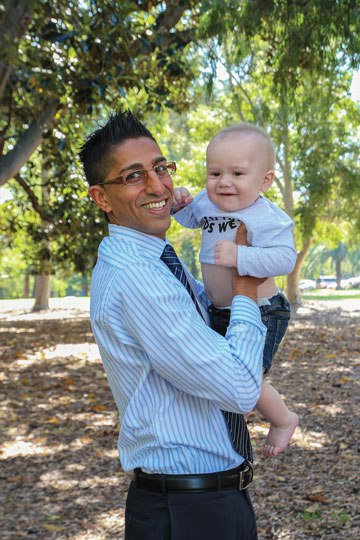Dr Rishi Kotecha knows too well the devastation of a leukaemia diagnosis in a child. While treating children with the disease as a consultant at Princess Margaret Hospital, he is also leading a team of researchers in the race to find a drug that will increase survival rates for infants.
Our aim is to always take research from the bedside to the bench and back to the bedside again.”
With this one statement, Dr Rishi Kotecha outlines the sense of urgency felt by a doctor who works as both a paediatric oncologist and a scientist searching for the cure.
Leukaemia is rare in babies who are less than one year of age. Perhaps one or two infants are diagnosed in Western Australia each year. Sadly, only 40 per cent of these young patients survive.
“Chemotherapy is very, very hard on a child, especially the babies,” Dr Kotecha said.
“Babies spend a lot of time in hospital because they suffer from a lot of toxicities occurring as a side effect of the chemotherapy. The families and their infant are trapped in hospital and that’s really difficult."

“It’s really hard on their little bodies – a lot of them go to intensive care with complications and many do unfortunately pass away. It’s extremely tricky to manage.”
Older children with leukaemia have a better prognosis, with a survival rate of up to 95 percent. It is this gap Dr Kotecha is working hard to close in the laboratory at The Kids Research Institute Australia, where he leads the research team alongside the Head of Leukaemia and Cancer Genetics, Professor Ursula Kees.
Looking forward, Dr Kotecha is excited about the research his team plans to conduct.
“It is the high-risk subgroups of leukaemia which have such poor outcomes that we are currently investigating,” he said.
“That will be my focus going into the future. Being a clinician, the emphasis will be looking at translational work that will help improve outcomes for our patients.”
It’s a thrilling time for the Leukaemia and Cancer Genetics Team, who published a paper earlier this year detailing their breakthrough discovery of a drug called Romidepsin, which works well in combination with traditional chemotherapy in laboratory models for infants with acute lymphoblastic leukaemia.
The research that led to this discovery had its genesis in the diagnosis of twin newborns many years ago, while Dr Kotecha was working on the ward.
“They were such little babies and I felt so sad at the time. I really wanted to help,” he said.
He began looking at the twins’ genetic features in the laboratory as the basis for his PhD, adding samples from other infants as more were diagnosed.
Dr Kotecha and his team produced models representing the disease in humans, which he was then able to use to test a variety of drugs. He found several classes of drugs that seemed to work.
The Kids Research Institute Australia Leukaemia Team are now testing the drugs identified by Dr Kotecha in mice.
“To validate our findings, we are now testing the drugs in mice that have the leukaemia,” Dr Kotecha said. “We look to see whether the new drug improves survival compared to no drug. When we find a drug linked to a good outcome, we then have to do combination testing to ensure that it is compatible with normal chemotherapy, because in the clinic we are going to be giving the new drugs in combination with standard chemotherapy.”
The team has just realised one of the drugs is working particularly well in the animal models in combination with chemotherapy.
The animal trials should be finished by the end of 2017, and from there the team hopes to move their findings to clinical trials.
Although such trials can take up to 10 years to finish, Dr Kotecha is hopeful his discovery will be available long before then.
“The reason we think we might get quicker results is that we are testing drugs that are already approved for use in patients,” he said. “They are not completely new drugs that have just been developed by pharmaceutical companies. They have already been approved for use in adults and older children."
“We are purposely picking FDA-approved drugs, which will accelerate translation into clinical trials.”
What’s next?
We hope to get the survival rate for babies with acute lymphoblastic leukaemia up to 70 per cent – more comparable to older children with high risk leukaemia – by doing collaborative research within international clinical trials groups.
